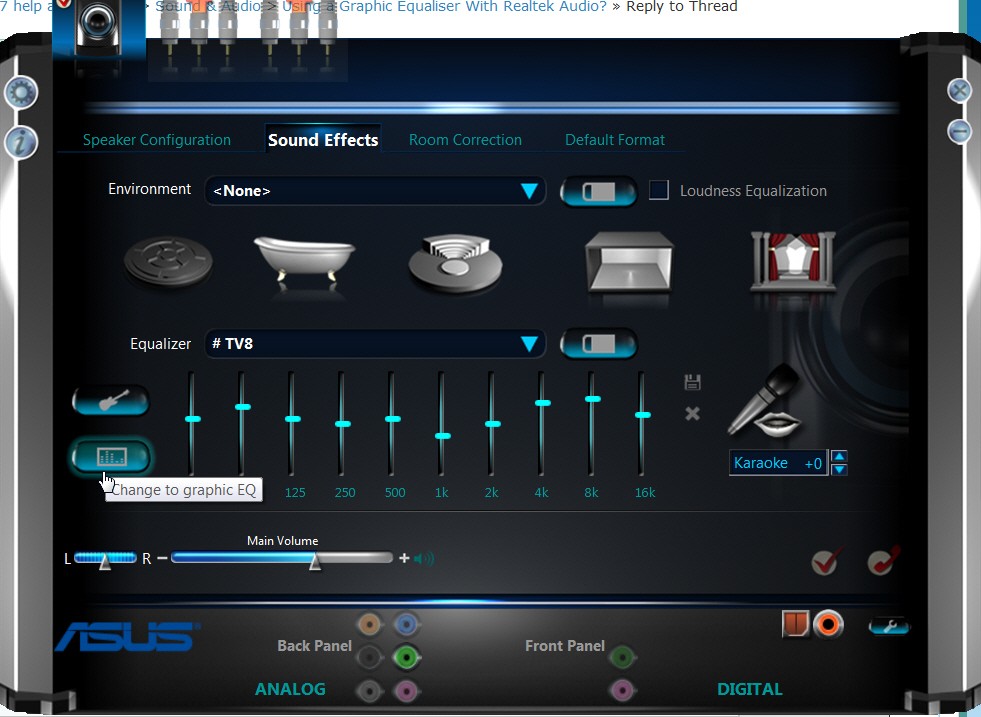
The answer to this is usually “Set it so when you hit the bypass button, the volume doesn't go up or down from the equalized signal.” If you raise a lot of bands above zero, this adds volume, so you will want to turn it down to match the original (bypassed) signal’s volume, and if you make mostly cuts, raise it to compensate. What About Volume Levels? One other question I get from time to time is “where do I set the volume control on the equalizer?”. In this article, I am using a 31 band EQ for reference, however it doesn't matter how many bands your particular equalizer has, the process and concept is exactly the same, you just listen to and set less frequencies. Once in awhile I will go through this process a 2nd time if I’m still not happy with it, or just go back and tweak certain frequencies.

You get to sample them all by hearing where it is you are affecting, and what too much and too little of it sounds like, and then you can find the happy medium where a frequency sounds “just right” to you. This method works great for beginners as well as pros because you are not only hearing what too much of, and too little of each frequency sounds like, you are also hearing where in the sound spectrum you are adjusting, so you don’t have to have perfect pitch and just “know” which frequencies you don’t like. The very LAST thing I do when I’m all done, and happy with how my sound spectrum sounds now, is LOOK at it. I continue this process with 63, 80, 100, 125 Hz etc.until I get to 20 Khz. I raise it up until I hear too much 50, and then all the way down to hear not enough 50, and then gradually up until it sounds “just right”. Then I go to the next frequency, let’s say 50 Hz. I then slowly raise it back up until it sounds “just enough”. These frequencies are usually unhearable, but their upper harmonics can wreak havoc in the hearable spectrum by distorting and cancelling some of the good frequencies we CAN hear.Ĭurve of Bass Roll Off Control at 63HzNext, starting at around 40 Hz, I raise the slider to hear what too much 40 Hz sounds like, and then lower it to hear what too little sounds like. Most speaker systems can’t reproduce frequencies below 40 Hz anyway, and that’s why most EQ’s have a high pass filter so you can set the frequency at which below this setting, the EQ is going to automatically lower the volume of those frequencies, and more so the farther below the filter’s setting they are.

Next, I start at the bottom by lowering 20-30 Hz, anything below 40. so I already get a general idea of which frequencies need adjusting. I use my ears to pick out where there is too much bass, midrange, not enough treble, harsh frequencies not pleasing to the ear, etc. The main reason for this is that I WANT to hear the sound the way it actually is before altering it. Where do I Start? OK, so what’s the correct answer? When it comes to a starting point, the only answer is #2 - The Flat Line! I always use the flat line as a starting point for equalizing anything for several reasons.


Although I’ve used this technique on really mushy, cluttered audio to “thin it out”, and it’s great for doing that, most audio in general is not that “crowded” across the sound spectrum. With this curve, try bypassing the EQ.it sounds exactly the same! #3: "Comb Filter" This term comes from the fact that every other slider is up, and every other adjacent one is down, much like a comb’s alternating teeth and spaces. If you could SEE sound, it might look very nice however, sound needs to be set with the ears, not the eyes! #2: "Flat Line" With this one comes an obvious question: Why would I set my EQ to "neutral" or "flat line"? Of course, the issue here is that the equalizer is doing absolutely nothing. You perhaps even VISUALIZE doing it whenever you approach an equalizer. Here is a breakdown of these 3 curves: #1: The "Smiley Face" You've SEEN this curve a hundred times, if not more. So, which one would you start with? Would you choose #1, #2, or #3? Why do I have a funny feeling that most of you will choose #1? Well, isn’t that the way you ALWAYS set an EQ? With more bass, more treble, and less midrange - after all, we want our audio to be clearer and really “pound”, right?


 0 kommentar(er)
0 kommentar(er)
